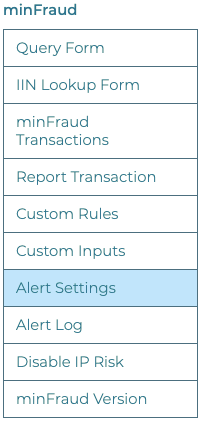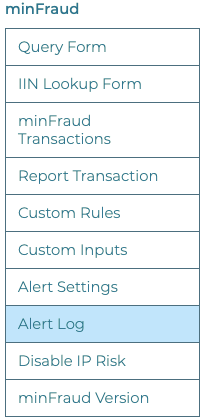How to receive minFraud alerts
When the minFraud service scores a transaction with a risk score of less than 10, we continue to monitor that transaction for 24 hours. During that time, if we receive new information that would cause us to rescore the transaction with a risk score of 75 or higher, we send out a minFraud alert to our affected customers.
Why we might raise the risk score on a transaction
A risk score may be raised if, after initially scoring a transaction, we see suspicious activity on the minFraud network from the IP address, email address, or other identifying information associated with the transaction. If a fraudster uses an IP or email address to engage in multiple transactions, we would flag that transaction information and raise the risk score for previous transactions. minFraud Alerts notify you when this occurs.
Currently, we may raise the risk of a previously scored transactions for one or more of the following reasons:
- The email used for the transaction was flagged as a high-risk email because it was associated with another high-risk transaction. Learn more about email risk data.
- The device used for the transaction has been marked as a high-risk device. Learn more about device tracking.
- The IP address used for the transaction has been marked as a high-risk IP because it was associated with another high-risk transaction.
- The IP address used for the transaction has been identified as an IP address associated with a hosting center. Learn more about anonymizer risk data.
- The IP address was used for a very high volume of orders across a wide number of locations in a short period of time. Learn more about velocity checks.
- Our data analysis team flags the transaction as risky after manual review.
Set up minFraud Alerts
You can set up your account to receive minFraud alerts by email and webhook, and review a log of all alerts. These features are available to admin users and standard users with product/service permissions. Learn more about user permissions.
You can access the settings for minFraud Alerts by clicking on the 'Alert Settings' link in the minFraud menu of your account portal [direct link, login required].

Set minFraud Alert email
You can receive minFraud Alerts to an email address. Enter the email address where you would like to receive minFraud Alerts in the box titled Alert Email, and then click on the blue Submit button.

Within the body of the email, you are able to provide instant feedback on whether a transaction looks risky or not. Providing this feedback helps improve the risk scoring for your account.

Set a webhook for minFraud Alerts
You can also receive minFraud Alerts by webhook, and integrate a response to these alerts on your server. The URL you use to receive minFraud Alerts should be an HTTPS endpoint set up to receive GET requests. For details about the format of these requests, please see the technical documentation on our developer portal.
When you have your endpoint set to receive minFraud Alerts, you can enter it in the Alert Webhook URL box, and then click on the blue Submit button.
Review minFraud Alert logs
You can view a record of minFraud Alerts associated with your transactions in your account portal.
Click on the 'Alert Log' link in the minFraud menu of your account portal [direct link, login required].

A chart will be displayed showing details about each transaction that triggered a minFraud Alert, including the initial risk score given the transaction, and the value of the rescore based on new information.
minFraud Alert logs expire after four months.